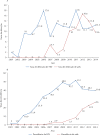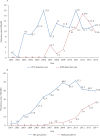Epidemiological aspects of HIV infection and AIDS among indigenous populations
- PMID: 31508778
- PMCID: PMC6758848
- DOI: 10.11606/S1518-8787.2019053000362
Epidemiological aspects of HIV infection and AIDS among indigenous populations
Abstract
Objective: To describe the epidemiological aspects of HIV infection and AIDS among indigenous peoples of the state of Mato Grosso do Sul, Brazil.
Methods: This is a descriptive epidemiological study on the occurrence and distribution of HIV infection and AIDS in the indigenous population assisted by the Distrito Sanitário Especial Indígena (Indigenous Special Health District) Mato Grosso do Sul between 2001 and 2014, based on three secondary databases. Annual rates of HIV and AIDS detection and prevalence were calculated, considering case distribution according to village, Health Base Pole and sociodemographic variables. Accumulated rates of detection, mortality and case fatality were calculated by ethnic group and for the Health Base Pole with the highest number of cases.
Results: The HIV detection rate fluctuated between 0.0 and 18.0/100 thousand people in the study period. For AIDS, there was no notification before 2007, but in 2012 its rate reached 16.6/100 thousand. HIV prevalence grew between 2001 and 2011, and it continuously grew for AIDS starting from 2007. The highest HIV detection rates occurred among Guarani peoples (167.1/100 thousand) and for AIDS, among the Kaiowá peoples (79.3/100 thousand); mortality and fatality rates were higher among the Kaiowá. Regarding the Dourados Health Base Pole, the AIDS detection rate increased, and the mortality and fatality rates decreased.
Conclusions: HIV infection and AIDS have been increasing among indigenous peoples, with distribution of the disease mainly in the Health Base Poles of the southern region of the state, where greater economic and social vulnerability are also observed. The endemic character of HIV and AIDS can become epidemic in some years given the existence of cases in other villages in the state. Its occurrence among the Guarani and Kaiowá populations indicates the need for expanded diagnosis, access to treatment and prevention measures.
OBJETIVO: Descrever os aspectos epidemiológicos da infecção pelo HIV e da aids entre povos indígenas do Mato Grosso do Sul.
MÉTODOS: Estudo epidemiológico descritivo sobre ocorrência e distribuição da infecção pelo HIV e aids na população indígena assistida pelo Distrito Sanitário Especial Indígena Mato Grosso do Sul, entre 2001 e 2014, a partir de três bases de dados secundários. Calcularam-se as taxas anuais de detecção e de prevalência de HIV e aids, com distribuição dos casos segundo aldeia, Polo Base e variáveis sociodemográficas. As taxas acumuladas de detecção, mortalidade e letalidade foram calculadas por etnia e para os Polos Base com o maior número de casos.
RESULTADOS: A taxa de detecção de HIV flutuou entre 0,0 e 18,0/100 mil pessoas no período. Para a aids, não houve notificação antes de 2007, mas em 2012 sua taxa chegou a 16,6/100 mil. A prevalência de HIV indicou crescimento entre 2001 e 2011, e para a aids observou-se aumento contínuo a partir de 2007. As maiores taxas de detecção de HIV ocorreram entre os Guarani (167,1/100 mil) e de aids, entre os Kaiowá (79,3/100 mil); as taxas de mortalidade e letalidade foram superiores entre os Kaiowá. Para o Polo Base de Dourados, observou-se elevação da taxa de detecção de aids e diminuição das taxas de mortalidade e letalidade.
CONCLUSÕES: A infecção pelo HIV e a aids mostraram-se crescentes entre povos indígenas, com distribuição da doença principalmente nos Polos Base da região sul do estado, onde observa-se também maior vulnerabilidade econômica e social. O caráter endêmico do HIV e da aids pode se tornar epidêmico em alguns anos, considerando a existência de casos em outras aldeias do estado. Sua ocorrência entre os Guarani e Kaiowá sinaliza a necessidade de ampliação do diagnóstico, do acesso ao tratamento e de medidas de prevenção.
Conflict of interest statement
Figures


References
-
- 1. Bastos FI, Cáceres C, Galvão J, Veras MA, Castilho EA. AIDS in Latin America: assessing the current status of the epidemic and the ongoing response. Int J Epidemiol. 2008;37(4):729-37. 10.1093/ije/dyn127 - DOI - PubMed
- Bastos FI, Cáceres C, Galvão J, Veras MA, Castilho EA. AIDS in Latin America: assessing the current status of the epidemic and the ongoing response. Int J Epidemiol. 2008;37(4):729–737. doi: 10.1093/ije/dyn127. - DOI - PubMed
-
- 2. Negin J, Aspin C, Gadsden T, Reading C. HIV among Indigenous peoples: a review of literature on HIV-related behaviour since the beginning of epidemic. AIDS Behav. 2015;19(9):1720-34. 10.1007/s10461-015-1023-0 - DOI - PMC - PubMed
- Negin J, Aspin C, Gadsden T, Reading C. HIV among Indigenous peoples: a review of literature on HIV-related behaviour since the beginning of epidemic. AIDS Behav. 2015;19(9):1720–1734. doi: 10.1007/s10461-015-1023-0. - DOI - PMC - PubMed
-
- 3. Centers for Disease Control and Prevention. HIV among American Indians and Alaska Natives in the United States. Atlanta: CDC; 2015 [cited 16 May 2017]. Available from: https://www.cdc.gov/hiv/group/racialethnic/aian/index.html
- Centers for Disease Control and Prevention . HIV among American Indians and Alaska Natives in the United States. Atlanta: CDC; 2015. [cited 16 May 2017]. https://www.cdc.gov/hiv/group/racialethnic/aian/index.html.
-
- 4. Public Health Agency of Canada. Estimates of HIV Prevalence and Incidence in Canada: summary. Toronto; 2011 [cited 22 May 2017]. Available from: https://www.canada.ca/en/public-health/services/publications/diseases-co...
- Public Health Agency of Canada . Estimates of HIV Prevalence and Incidence in Canada: summary. Toronto: 2011. [cited 22 May 2017]. https://www.canada.ca/en/public-health/services/publications/diseases-co....
-
- 5. Shea B, Aspin C, Ward J, Archibald C, Dickson N, McDonald A, et al. HIV diagnoses in indigenous peoples: comparison of Australia, Canada and New Zealand. Int Health. 2011;3(3):193-8. 10.1016/j.inhe.2011.03.010 - DOI - PubMed
- Shea B, Aspin C, Ward J, Archibald C, Dickson N, McDonald A, et al. HIV diagnoses in indigenous peoples: comparison of Australia, Canada and New Zealand. Int Health. 2011;3(3):193–198. doi: 10.1016/j.inhe.2011.03.010. - DOI - PubMed
MeSH terms
LinkOut - more resources
Full Text Sources
Medical

